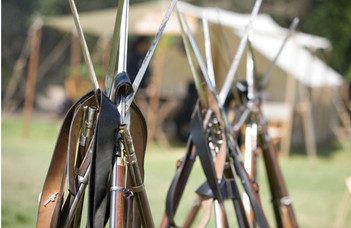Bayonets for Sale: Types and Function
May 9th 2023
Ever since the development of the first firearms, enterprising military commanders, soldiers, and gunsmiths have been making an attempt to strike a compromise for the platform’s inherent dependency on ammunition.
Throughout much of history, the solution was the bayonet - an edged weapon, often adjacent to a knife, sword, dagger, or spike - that could be affixed to or near the muzzle of the weapon.
The bayonet compromised for the weapon when it ran out of ammunition, and made it possible for an infantryman to continue on with offensive manuevers even in the absence of ordnance.
There are four main categories of bayonets, most of which can be categorized accordingly. If you’re here looking for bayonets for sale, consider the following.
Plug Bayonets
Though effectively nonexistent today, the earliest bayonets were plug bayonets.
As the name suggests, plug bayonets are designed to fit into the muzzle of a gun, like a plug. Firearms that accept plug bayonets lacked bayonet sockets or lugs.
The plug bayonet is the most simplistic of all and it was practical only for use with muzzleloaders, but it had obvious drawbacks.
Notably, the firearm cannot be fired with the bayonet “affixed,” thus severely limiting its utility.
It wasn’t long before firearm design advanced to socket bayonets, which became widespread even before breech-loading arms took off.
Socket Bayonets
The adaptation of the socket bayonet has been attributed by some to a Scottish General named Hugh MacKay, who claimed that, in 1689 at the Battle of Kiliecrankie, his forces were overwhelmed by Highlanders because it was too cumbersome for his Loyalist troops to affix their plug bayonets after firing.
The rest, as they say, is history, with socket-style bayonets predominating for the next hundred years if not longer.
In the socket configuration, there is a ring or socket around the muzzle of a firearm, into which a bayonet can be inserted. Usually, with a partial rotation of a ring encircling the bayonet, it can be locked into place, preventing it from falling off.
Many muskets and rifles have been configured to accept socket-style bayonets, such as the British Land Pattern musket (A.K.A. Brown Bess), .58 caliber M1863 rifle-muskets, and even Mosin-Nagant rifles.
Unlike the plug bayonet, the socket-style bayonet could be fixed before firing a volley, giving a decided advantage over earlier plug-style bayonets.

Sword Bayonets
By the early 1800s, another style of bayonet, called the sword bayonet, was rising in popularity. Sword bayonets are long and have either one or two edges, like a sword, often extending 16 inches or longer from hilt to tip.
The intent behind the design of the sword bayonet was initially to serve as a short sword, giving riflemen greater reach for the purposes of fending off attacks from cavalry.
The design of the sword bayonet, which like a sword, had a hilt that could be grasped and not just a socket that would be unwieldy in the grip, made it a much more versatile weapon. It also necessitated the development of the bayonet lug, in lieu of the socket or ring.
Armed with sword bayonets, riflemen could reap the benefits of a weapon that was a dual firearm and pole weapon, merging the best attributes of both.
Multi-Purpose Bayonets
On the eve of the First World War, many official bayonets in circulation, like the Japanese Type 30 Arisaka bayonet, the German M1898 bayonet, and the United States M1905 bayonet, were sword-style bayonets.
In the latter case, of the M1905, the bayonet was 16” in overall length. This gave a soldier unparalleled reach but was soon to meet its match in the close confines of trench warfare.
During and through World War One, the general design of the bayonet grew progressively shorter and shorter, due in part to the limitations that trench warfare placed on long, ungainly weapons in close-quarters combat.
At a certain point, bayonets shrank to such a degree that they were hardly larger than fighting knives with 6-inch blades. Though this curtailed their reach, it also made the weapons paired with them more nimble, and it also meant that the bayonet could be removed and used manually, either as a fighting knife or a utility knife.
Some bayonets during the First World War were also adapted into sawback bayonets, which had teeth on their spines and could be used for cutting through wood, rope, and barbed wire.
Looking for Bayonets for Sale? Shop Online or Visit Us in Easton
Do you still have questions about bayonets for sale? Are you here looking for a specific model bayonet for your rifle, such as an M1905 bayonet for a Springfield 1903 rifle or an M4 bayonet designed for use with an M1 Carbine?
Get in touch with us directly if you have questions about history, parts, or compatibility. You can reach us at 610-250-3960 or visit us in our showroom at 50 Hilton Street in Easton, Pennsylvania.

